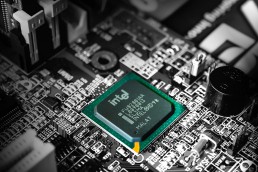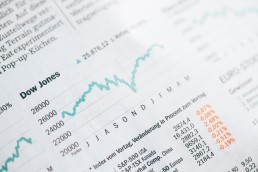DIA
First assembled in 1896, the Dow Jones Industrial Average is a stock market index that tracks the performance of 30 “blue chip” companies across a range of industries on U.S. exchanges. It is not weighted by market cap or arithmetic mean, though it is price weighted and does offer a broad snapshot of the performance of U.S. stocks at any given moment. The SPDR Dow Jones Industrial Average ETF Trust (DIA) is designed to follow the performance of this index.
DIA holds 30 companies across nine sectors, including Industrials (making up 20.35% of the portfolio), Information Technology (19.69%), Financials (14.91%), Consumer Discretionary (13.62%), Health Care (11.76%), Consumer Staples (8.89%), Communication Services (4.80%), Energy (4.77%) and Materials (1.20%). Its top 10 holdings are Boeing (9.58%), Home Depot (5.84%), Apple (5.64%), UnitedHealth (5.47%), McDonald’s (5.40%), Goldman Sachs (5.22%), Visa (4.33%), 3M (4.14%), Travelers (3.74%) and IBM (3.66%).
DIA’s gross expense ratio is 0.17% and it currently has about $275 billion in assets under management.
Rationale
The most direct way to gain exposure to the holdings in DIA is to buy its listed shares. But there are a number of good reasons for investors to reconsider that approach. Unlike total market ETFs, DIA is weighted to mirror the Dow Jones Industrial Average, rather than broader weighted indexes like the S&P 500. This potentially ties investment outcomes to the Dow’s weightings, limiting returns from a broader index. Rather than buying DIA shares themselves, investors interested in gaining exposure to the Dow components might consider buying funds that provide exposure to its top-weighted sectors, including Industrials, Information Technology and Financials. After all, the return drivers that will benefit DIA might also benefit other funds that are even more diversified.
Investing in DIA
A search on Magnifi suggests that investors can gain access to the Dow Jones Industrial Average via a number of different funds and other ETFs, including those shown below.
Schedule a demo and unlock
a 14-day free trial of Magnifi Pro+
Magnifi is changing the way we shop for investments, with the world’s first semantic search engine for finance that helps users discover, compare and buy investment products such as ETFs, mutual funds and stocks. Open a Magnifi investment account today.
This blog is sponsored by Magnifi. The information and data are as of the publish date unless otherwise noted and subject to change. This material is provided for informational purposes only and should not be construed as individualized investment advice or an offer or solicitation to buy or sell securities tailored to your needs. This information covers investment and market activity, industry or sector trends, or other broad-based economic or market conditions and should not be construed as investment research or advice. Investors are urged to consult with their financial advisors before buying or selling any securities. Although certain information has been obtained from sources believed to be reliable, we do not guarantee its accuracy, completeness or fairness. Past performance is no guarantee of future results. This content may not be reproduced or distributed to any person in whole or in part without the prior written consent of Magnifi. [As a technology company, Magnifi provides access to tools and will be compensated for providing such access. Magnifi does not provide broker-dealer, custodian, investment advice or related investment services.]
VTI
Like the SPDR S&P 500 ETF (SPY), the Vanguard Total Stock Market ETF (VTI) is designed to track the performance of the overall U.S. stock market, but with a slight twist that can impact results. Unlike SPY, Vanguard’s offering mirrors the CRSP US Total Market Index, including large-, mid- and small-cap equities that are diversified across growth and value styles, offering a broad snapshot of the market as a whole.
VTI holds a wide range of companies across 10 sectors, including: Basic Materials (2.20%), Consumer Goods (8.00%), Consumer Services (13.40%), Financials (19.80%), Health Care (12.70%), Industrials (13.30%), Oil & Gas (4.00%), Technology (21.20%), Telecommunications (2.00%), and Utilities (3.40%). As of October 2019, its 10 largest holdings, accounting for 19.40% of total net assets are Microsoft, Apple, Alphabet, Amazon, Facebook, Berkshire Hathaway, JPMorgan Chase, Johnson & Johnson, Procter & Gamble and Visa.
The ETF’s gross expense ratio is 0.03% and VTI currently has about $845 billion in assets under management.
Rationale
Naturally, the most direct way to gain exposure to the holdings in VTI is to buy its listed shares. But there are a number of good reasons for investors to reconsider that approach. Unlike SPY, VTI is weighted to mirror the CRSP US Total Market Index, rather than directly tied to the S&P 500’s focus. This exposes investors to sectors of the stock market that may not be as heavily invested as most S&P-focused funds. Rather than buying VTI shares themselves, investors interested in gaining exposure to this broad index might consider buying funds that provide exposure to its top-weighted sectors, including technology, financials and consumer goods, in order to spread out their investments even more broadly than VTI does. After all, the return drivers that will benefit VTI might also benefit other funds that are even more diversified.
Investing in VTI
A search on Magnifi suggests that investors can gain access to the CRSP US Total Market Index via a number of different funds and other ETFs, including those shown below.
Schedule a demo and unlock
a 14-day free trial of Magnifi Pro+
Magnifi is changing the way we shop for investments, with the world’s first semantic search engine for finance that helps users discover, compare and buy investment products such as ETFs, mutual funds and stocks. Try it for yourself today.
This blog is sponsored by Magnifi. The information and data are as of the publish date unless otherwise noted and subject to change. This material is provided for informational purposes only and should not be construed as individualized investment advice or an offer or solicitation to buy or sell securities tailored to your needs. This information covers investment and market activity, industry or sector trends, or other broad-based economic or market conditions and should not be construed as investment research or advice. Investors are urged to consult with their financial advisors before buying or selling any securities. Although certain information has been obtained from sources believed to be reliable, we do not guarantee its accuracy, completeness or fairness. Past performance is no guarantee of future results. This content may not be reproduced or distributed to any person in whole or in part without the prior written consent of Magnifi. [As a technology company, Magnifi provides access to tools and will be compensated for providing such access. Magnifi does not provide broker-dealer, custodian, investment advice or related investment services.]
SMH
The VanEck Vectors Semiconductor ETF (SMH) is designed to replicate the MVIS US Listed Semiconductor 25 Index, which tracks the overall performance of companies involved in semiconductor production and equipment. Beyond that, SMH focuses on the most liquid companies in the industry based on market cap and trading volume, with a bias toward large, well-established semiconductor companies. It invests in both domestic and U.S. listed foreign companies.
SMH’s top holdings include Taiwan Semiconductor Manufacturing Co. (13.42%), Intel (11.80%), Nvidia (5.77%), Texas Instruments (5.19%), Asml Holding (5.11%), Lam Research (4.89%), Advanced Micro Devices (4.85%), Qualcomm (4.81%) Broadcom (4.70%) and Applied Material (4.53%). Companies in the United States makes up 74.77% of its portfolio, followed by Taiwan at 13/42% and the Netherlands at 9.55%.
SMH’s expense ratio is 0.39% and it currently has about $1.6 billion in assets under management.
Rationale
The most direct way to gain exposure to the holdings in SMH is to buy its listed shares. But there are a number of good reasons for investors to reconsider that approach. While SMH seeks to mirror the global semiconductor market, there are different weightings and investment approaches to this sector that might perform differently in different investment environments. Rather than buying SMH shares themselves, investors interested in a semiconductor ETF that’s weighted differently or takes a more global approach might consider buying funds that provide exposure to similar semiconductor firms. After all, the return drivers that will benefit SMH might also benefit other funds focused on the semiconductor space.
Investing in SMH
A search on Magnifi suggests that investors can gain access to the semiconductor market via a number of different funds and other ETFs, including those shown below.
Schedule a demo and unlock
a 14-day free trial of Magnifi Pro+
Magnifi is changing the way we shop for investments, with the world’s first semantic search engine for finance that helps users discover, compare and buy investment products such as ETFs, mutual funds and stocks. Open a Magnifi investment account today.
This blog is sponsored by Magnifi. The information and data are as of the publish date unless otherwise noted and subject to change. This material is provided for informational purposes only and should not be construed as individualized investment advice or an offer or solicitation to buy or sell securities tailored to your needs. This information covers investment and market activity, industry or sector trends, or other broad-based economic or market conditions and should not be construed as investment research or advice. Investors are urged to consult with their financial advisors before buying or selling any securities. Although certain information has been obtained from sources believed to be reliable, we do not guarantee its accuracy, completeness or fairness. Past performance is no guarantee of future results. This content may not be reproduced or distributed to any person in whole or in part without the prior written consent of Magnifi. [As a technology company, Magnifi provides access to tools and will be compensated for providing such access. Magnifi does not provide broker-dealer, custodian, investment advice or related investment services.]
QQQ
Another of the oldest exchange traded funds (ETFs) on the market, the Invesco QQQ ETF (QQQ) was launched in 1999 as a way for investors to track the tech-focused NASDAQ-100 index. Now, two decades into its run, QQQ remains in the top 1% of all NASDAQ-focused ETFs in terms of assets under management. As of 2019, QQQ has maintained a top 1% ranking in the Lipper’s Large-Cap Growth Category for the past 10 and 15 years and is the second-most traded ETF in the U.S. based on average daily volume.
QQQ’s holdings are broken down into six categories, each weighted differently. Information technology gets 44.44%, Communications 21.40%, Consumer Discretionary 16.90%, Healthcare 7.98% Consumer Staples 6.07% and Industrials & Utilities 2.83%. Its top holdings include Microsoft (11.21%), Apple (9.95%), Cisco (2.84%), Intel (2.60%, Adobe (1.74%), Paypal (1.63%), Broadcom (1.38%), Texas Instruments (1/31%), Nvidia (1.21%) and Qualcomm (1.12%).
QQQ’s expense ratio is 0.20% and it currently has about $82 billion in assets under management.
Rationale
Naturally, the most direct way to gain exposure to the holdings in QQQ is to buy its listed shares. But there are a number of good reasons for investors to reconsider that approach. There are a number of different versions of the QQQ approach, each with slightly different weightings, and for good reason. The tech-focused NASDAQ is famously volatile, so ETFs that track it generally try to smooth out these ups and downs through more active management and different weightings. Rather than buying QQQ shares themselves, investors interested in a technology ETF that’s either more conservative or more aggressive might consider buying funds that provide exposure to its top-weighted sectors, in order to spread out their investments even more broadly than QQQ does. After all, the return drivers that will benefit QQQ might also benefit other funds that are even more diversified.
Investing in QQQ
A search on Magnifi suggests that investors can gain access to the NASDAQ-100 via a number of different funds and other ETFs, including those shown below.
Schedule a demo and unlock
a 14-day free trial of Magnifi Pro+
Magnifi is changing the way we shop for investments, with the world’s first semantic search engine for finance that helps users discover, compare and buy investment products such as ETFs, mutual funds and stocks. Open a Magnifi investment account today.
This blog is sponsored by Magnifi. The information and data are as of the publish date unless otherwise noted and subject to change. This material is provided for informational purposes only and should not be construed as individualized investment advice or an offer or solicitation to buy or sell securities tailored to your needs. This information covers investment and market activity, industry or sector trends, or other broad-based economic or market conditions and should not be construed as investment research or advice. Investors are urged to consult with their financial advisors before buying or selling any securities. Although certain information has been obtained from sources believed to be reliable, we do not guarantee its accuracy, completeness or fairness. Past performance is no guarantee of future results. This content may not be reproduced or distributed to any person in whole or in part without the prior written consent of Magnifi. [As a technology company, Magnifi provides access to tools and will be compensated for providing such access. Magnifi does not provide broker-dealer, custodian, investment advice or related investment services.]
SPY
Exchange traded funds (ETFs) are now one of the most popular publicly-traded investment vehicles on the market, with nearly $3.5 trillion in assets under management across all ETFs as of 2018, and it all started with the SPDR S&P 500 ETF Trust (SPY), which launched as the first-ever ETF on January 22, 1993. Named for the Standard & Poor’s Depositary Receipts, SPY tracks the S&P 500 stock market index and is today the largest ETF in the world with roughly $280 billion in assets under management.
The S&P 500 Index holds large cap U.S. companies across all 11 GICS sectors, and SPY is designed to mirror that weighting, effectively tracking the broad U.S. stock market. SPY’s top holdings include (in order): Microsoft (4.43%), Apple (4.37%), Amazon (2.81%), Facebook (1.85%), Berkshire Hathaway Class B (1.66%), JPMorgan Chase (1.61%), Alphabet (1.53% Class C and 1.52% Class A), Johnson & Johnson (1.37%) and Visa (1.22%).
The ETF’s gross expense ratio is 0.0945% and each share is designed to be worth 1/10 of the cash S&P 500’s current level.
Rationale
Naturally, the most direct way to gain exposure to the holdings in SPY is to buy its listed shares. But there are a number of good reasons for investors to reconsider that approach. SPY is weighted to directly mirror the S&P 500, with a heavy focus toward technology, but it is worth considering if that is the correct approach going forward. Rather than buying SPY shares themselves, investors interested in gaining exposure to the broad S&P 500 Index might consider buying funds that provide exposure to its top-weighted sectors, including information technology, healthcare and energy, in order to spread out their investments even more broadly than SPY does. After all, the return drivers that will benefit SPY might also benefit other funds that are even more diversified.
Investing in SPY
A search on Magnifi suggests that investors can gain access to the S&P 500 via a number of different funds and other ETFs, including those shown below.
Schedule a demo and unlock
a 14-day free trial of Magnifi Pro+
Magnifi is changing the way we shop for investments, with the world’s first semantic search engine for finance that helps users discover, compare and buy investment products such as ETFs, mutual funds and stocks. Open a Magnifi investment account today.
This blog is sponsored by Magnifi. The information and data are as of the publish date unless otherwise noted and subject to change. This material is provided for informational purposes only and should not be construed as individualized investment advice or an offer or solicitation to buy or sell securities tailored to your needs. This information covers investment and market activity, industry or sector trends, or other broad-based economic or market conditions and should not be construed as investment research or advice. Investors are urged to consult with their financial advisors before buying or selling any securities. Although certain information has been obtained from sources believed to be reliable, we do not guarantee its accuracy, completeness or fairness. Past performance is no guarantee of future results. This content may not be reproduced or distributed to any person in whole or in part without the prior written consent of Magnifi. [As a technology company, Magnifi provides access to tools and will be compensated for providing such access. Magnifi does not provide broker-dealer, custodian, investment advice or related investment services.]
JNUG
The Direxion Daily Junior Gold Miners Index (JNUG) is tied to the performance of the MVIS Global Junior Gold Miners Index, which tracks the performance of foreign and domestic micro-, small- and mid-cap gold and silver mining companies. But JNUG adds a layer to the typical index ETF approach, seeking daily investment results that are three times that of the underlying index. It accomplishes this through the use of leverage.
JNUG’s top holdings include Kinross Gold (6.12% weighting), Evolution Mining (5.59%), Northern Star Resources (4.91%), Pan American (4.27%), Gold Fields (4.14%), Comp De Minas (4.05%), Yamana Gold (3.88%), Sibanye Gold (3.39%), B2Gold (3.03%), and Detour Gold (2.87%).
JNUG’s expense ratio is 1.17% and it currently has about $935 million in assets under management.
Rationale
The most direct way to gain exposure to the holdings in JNUG is to buy its listed shares. But there are a number of good reasons for investors to reconsider that approach. JNUG is just one of a pair of ETFs that are tracking the gold miners market. JNUG is the bullish (upside) listing, while JDST is the bearish (downside) short version. Both intend to deliver positive results but are optimized for opposite market conditions. This said, rather than buying JNUG shares themselves, investors interested in gaining exposure to the gold mining market as a whole might consider buying funds that provide exposure to its top-weighted companies. After all, the return drivers that will benefit JNUG might also benefit other funds in the sector.
Investing in JNUG
A search on Magnifi suggests that investors can gain access to the gold miners of the world via a number of different funds and other ETFs, including those shown below.
Schedule a demo and unlock
a 14-day free trial of Magnifi Pro+
Magnifi is changing the way we shop for investments, with the world’s first semantic search engine for finance that helps users discover, compare and buy investment products such as ETFs, mutual funds and stocks. Open a Magnifi investment account today.
This blog is sponsored by Magnifi. The information and data are as of the publish date unless otherwise noted and subject to change. This material is provided for informational purposes only and should not be construed as individualized investment advice or an offer or solicitation to buy or sell securities tailored to your needs. This information covers investment and market activity, industry or sector trends, or other broad-based economic or market conditions and should not be construed as investment research or advice. Investors are urged to consult with their financial advisors before buying or selling any securities. Although certain information has been obtained from sources believed to be reliable, we do not guarantee its accuracy, completeness or fairness. Past performance is no guarantee of future results. This content may not be reproduced or distributed to any person in whole or in part without the prior written consent of Magnifi. [As a technology company, Magnifi provides access to tools and will be compensated for providing such access. Magnifi does not provide broker-dealer, custodian, investment advice or related investment services.]
UVXY
As a leveraged fund, the ProShares Ultra VIX Short-Term Futures ETF (UVXY) seeks daily investment results that are one and one-half times (1.5x) the daily performance of the S&P 500 VIX Short-Term Futures Index, which tracks a portfolio of monthly VIX futures contracts. It’s a play on U.S. stock market volatility.
As a leverage ETF, UVXY is designed to help investors profit from increases in the expected volatility of the S&P 500 while also reducing their portfolio risk, since changes in the VIX Short-Term Futures Index have historically been negatively correlated to S&P 500 returns.
UVXY’s expense ratio is 0.95% and it has about $584 million in assets under management.
Rationale
The most direct way to gain exposure to the UVXY approach to the short-term VIX is to buy its listed shares. But there are a number of good reasons for investors to reconsider that. UVXY gas underperformed broadly since inception in 2011, amid a fairly steady growth period for the overall U.S. equities market. This mirrors the trend in the VIX overall. Rather than buying UVXY shares themselves, investors interested in gaining exposure to both short- and mid-term protection that’s tied to the VIX might consider buying funds that provide exposure to similar VIX positions.
Investing in UVXY
A search on Magnifi suggests that investors can gain access to the VIX via a number of different funds and other ETFs, including those shown below.
Schedule a demo and unlock
a 14-day free trial of Magnifi Pro+
Magnifi is changing the way we shop for investments, with the world’s first semantic search engine for finance that helps users discover, compare and buy investment products such as ETFs, mutual funds and stocks. Open a Magnifi investment account today.
This blog is sponsored by Magnifi. The information and data are as of the publish date unless otherwise noted and subject to change. This material is provided for informational purposes only and should not be construed as individualized investment advice or an offer or solicitation to buy or sell securities tailored to your needs. This information covers investment and market activity, industry or sector trends, or other broad-based economic or market conditions and should not be construed as investment research or advice. Investors are urged to consult with their financial advisors before buying or selling any securities. Although certain information has been obtained from sources believed to be reliable, we do not guarantee its accuracy, completeness or fairness. Past performance is no guarantee of future results. This content may not be reproduced or distributed to any person in whole or in part without the prior written consent of Magnifi. [As a technology company, Magnifi provides access to tools and will be compensated for providing such access. Magnifi does not provide broker-dealer, custodian, investment advice or related investment services.]
SH
The ProShares Short S&P500 ETF (SH) seeks daily investment results that are the inverse of the daily performance of the S&P 500 stock index. This means that when the S&P goes down for the day, SH goes up, and vice versa.
The S&P 500 Index holds large cap U.S. companies across all 11 GICS sectors, although SH is not designed to mirror that weighting but rather effectively offset the performance of the broad U.S. stock market. In order to achieve its goals, SH invests in a range of derivatives, swap agreements and futures contracts, with additional holdings in U.S. Treasury Bills and select Repurchase Agreements.
SH’s expense ratio is 0.89% and the fund has about $1.9 billion in assets under management.
Rationale
Naturally, the most direct way to gain exposure to the SH approach to the market is to buy its listed shares. But there are a number of good reasons for investors to reconsider that approach. After all, shorting the S&P500 on a daily basis is a technique that investors can use directly themselves, potentially adapting more quickly to changing market conditions than SH’s broad-based portfolio approach. Rather than buying SH shares themselves, investors interested in gaining inverse exposure to the broad S&P 500 Index might consider buying funds that provide similar exposure. After all, the return drivers that will benefit SPY might also benefit other funds that are more diversified.
Investing in SH
A search on Magnifi suggests that investors can gain access to the inverse of the S&P 500 via a number of different funds and other ETFs, including those shown below.
Schedule a demo and unlock
a 14-day free trial of Magnifi Pro+
Magnifi is changing the way we shop for investments, with the world’s first semantic search engine for finance that helps users discover, compare and buy investment products such as ETFs, mutual funds and stocks. Open a Magnifi investment account today.
This blog is sponsored by Magnifi. The information and data are as of the publish date unless otherwise noted and subject to change. This material is provided for informational purposes only and should not be construed as individualized investment advice or an offer or solicitation to buy or sell securities tailored to your needs. This information covers investment and market activity, industry or sector trends, or other broad-based economic or market conditions and should not be construed as investment research or advice. Investors are urged to consult with their financial advisors before buying or selling any securities. Although certain information has been obtained from sources believed to be reliable, we do not guarantee its accuracy, completeness or fairness. Past performance is no guarantee of future results. This content may not be reproduced or distributed to any person in whole or in part without the prior written consent of Magnifi. [As a technology company, Magnifi provides access to tools and will be compensated for providing such access. Magnifi does not provide broker-dealer, custodian, investment advice or related investment services.]
TVIX
Targeting the market of sophisticated, institutional investors who are looking for advanced, turnkey investment solutions, the VelocityShares Daily 2x VIX Short-Term ETN (TVIX) is designed to seek returns that are double those of the S&P 500 VIX Short-Term Futures Index ER every day. As a play on U.S. stock volatility, TVIX is tied to the S&P 500 VIX Short-Term Futures Index.
[Trading TVIX: What Investors Need to Know]
TVIX provides 2x leveraged exposure to an index comprising first- and second-month VIX future positions resulting in a weighted average maturity of 1 month. In order to achieve its goals, its holdings can vary broadly from day to day based on market conditions. On a recent day, for instance, 100% of TVIX’s assets were in CBOE Short-Term VIX Futures with a December 2019 expiration date.
Launched in 2010, TVIX has an expense ratio of 1.65% and about $918 million in assets under management.
Rationale
The most direct way to gain exposure to the TVIX approach to the market is to buy its listed shares. But there are a number of good reasons for investors to reconsider that. With a fairly high expense ratio, TVIX is automating a fairly simple trade for most investors to mimic. Rather than buying TVIX shares themselves, investors interested in gaining exposure to both short- and mid-term protection might consider buying funds that provide exposure to similar VIX future positions.
Investing in TVIX
A search on Magnifi suggests that investors can gain access to the VIX futures via a number of different funds and other ETFs, including those shown below.
Schedule a demo and unlock
a 14-day free trial of Magnifi Pro+
Magnifi is changing the way we shop for investments, with the world’s first semantic search engine for finance that helps users discover, compare and buy investment products such as ETFs, mutual funds and stocks. Open a Magnifi investment account today.
This blog is sponsored by Magnifi. The information and data are as of the publish date unless otherwise noted and subject to change. This material is provided for informational purposes only and should not be construed as individualized investment advice or an offer or solicitation to buy or sell securities tailored to your needs. This information covers investment and market activity, industry or sector trends, or other broad-based economic or market conditions and should not be construed as investment research or advice. Investors are urged to consult with their financial advisors before buying or selling any securities. Although certain information has been obtained from sources believed to be reliable, we do not guarantee its accuracy, completeness or fairness. Past performance is no guarantee of future results. This content may not be reproduced or distributed to any person in whole or in part without the prior written consent of Magnifi. [As a technology company, Magnifi provides access to tools and will be compensated for providing such access. Magnifi does not provide broker-dealer, custodian, investment advice or related investment services.]
Intel (INTC)
The Silicon Valley region of California’s Bay Area got its name in the 1960s as a result of the many semiconductor companies that were established in the area, making the silicon-based chips that were powering the computer revolution. At the forefront of this movement was Intel (INTC), a company founded by two of luminaries of information technology – Robert Noyce, the inventor of the integrated circuit, and Gordon Moore, the developer of “Moore’s law” of technological development – that emerged as an early leader in both SRAM and DRAM memory chips, as well as the x86 series of microprocessors that drove the vast majority of personal computers starting in the 1980s.
Today Intel continues to manufacture processors for mobile and desktop use, as well as computer hardware infrastructure like motherboards, network interface controllers, memory chips, graphics controllers and more. Intel’s primary competitor to this day is AMD, the number-two U.S. maker of integrated circuits.
In 2018, Intel reported more than $70 billion in revenue and employed more than 110,000 people in facilities all over the world.
Rationale
The most direct way to gain exposure to INTC is to buy its listed shares. But there are a number of good reasons for investors to reconsider that approach. As of 2018, Intel remains a world leader in semiconductor development and manufacturing. But it is starting to grip on the world market, recently losing its title of world’s largest semiconductor to South Korea’s Samsung Electronics. What’s more, as mobile computer begins to fully displace traditional desktop and laptop computers, there is less of a need for Intel’s specialized hardware. That pivot is only accelerating and could start to drag down Intel’s long-term growth.
However, rather than buying INTC shares themselves, investors interested in gaining exposure to the information technology and semiconductor sectors might consider buying funds that provide exposure to Intel and its competitors. After all, the return drivers that will benefit INTC might also benefit other similar companies in information technology, computing, and semiconductor manufacturing. As investment management is gradually moving to the construction of portfolios using ETFs and mutual funds in addition to single stocks, investors would do well to consider gain exposure to firms like INTC through these types of funds.
Investing in INTC
A search on Magnifi suggests that investors can gain access to INTC via a number of different funds and ETFs, including those shown below.
Schedule a demo and unlock
a 14-day free trial of Magnifi Pro+
Magnifi is changing the way we shop for investments, with the world’s first semantic search engine for finance that helps users discover, compare and buy investment products such as ETFs, mutual funds and stocks. Try it for yourself today.
This blog is sponsored by Magnifi. The information and data are as of the publish date unless otherwise noted and subject to change. This material is provided for informational purposes only and should not be construed as individualized investment advice or an offer or solicitation to buy or sell securities tailored to your needs. This information covers investment and market activity, industry or sector trends, or other broad-based economic or market conditions and should not be construed as investment research or advice. Investors are urged to consult with their financial advisors before buying or selling any securities. Although certain information has been obtained from sources believed to be reliable, we do not guarantee its accuracy, completeness or fairness. Past performance is no guarantee of future results. This content may not be reproduced or distributed to any person in whole or in part without the prior written consent of Magnifi. [As a technology company, Magnifi provides access to tools and will be compensated for providing such access. Magnifi does not provide broker-dealer, custodian, investment advice or related investment services.]








